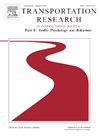Predicting emergency decision-making in conditionally automated driving from personality traits and heart rate
IF 3.5
2区 工程技术
Q1 PSYCHOLOGY, APPLIED
Transportation Research Part F-Traffic Psychology and Behaviour
Pub Date : 2025-05-24
DOI:10.1016/j.trf.2025.05.011
引用次数: 0
Abstract
Emergency situations in conditionally automated driving force the driver to quickly take over control from the artificial intelligence (AI). Studying which aspects can influence such driver decisions is crucial for developing safer automated driving technologies. In the present study, we hence ask whether decision-making both during and after take over can be predicted based on personal factors as well as physiological measures. Our experiment employed a realistic virtual reality (VR) scenario with an automated driving environment in which participants were able to change the driving mode. The scenario’s driving course contained multiple forks indicated by warning signs for which one direction was “safe” and the other led to a cliff. During the testing phase, pedestrians suddenly blocked the safe direction, and the AI informed the driver that it would steer the car off the cliff. Here, participants had two, staged decisions to make: whether to switch to manual driving or to continue in automated driving, and if they had switched, whether to “self-sacrifice” to save the pedestrians or not. In our sample of N = 108 participants, 83.3 % made the switch, and of these, 56.7 % steered away from the cliff trying to save themselves. Importantly, statistical analyses showed significant influence of psychopathy, perspective taking, gender, and heart rate on the decision-making after take over. Based on this data, we created a hard-voting prediction model that outperformed other machine learning benchmark algorithms, showing that it is possible to predict drivers’ decision-making after take over from personal and physiological data.
从人格特征和心率预测有条件自动驾驶中的紧急决策
有条件自动驾驶中的紧急情况迫使驾驶员迅速从人工智能(AI)手中接管控制权。研究哪些因素会影响驾驶员的决策,对于开发更安全的自动驾驶技术至关重要。因此,在本研究中,我们想知道在接管期间和之后的决策是否可以基于个人因素和生理指标来预测。我们的实验采用了逼真的虚拟现实(VR)场景和自动驾驶环境,参与者可以在其中改变驾驶模式。该场景的驾驶路线包含多个岔路口,这些岔路口都有警告标志,其中一个方向是“安全的”,另一个方向则通向悬崖。在测试阶段,行人突然挡住了安全方向,人工智能就会通知司机,它会把车开下悬崖。在这里,参与者有两个分阶段的决定:是切换到手动驾驶还是继续自动驾驶,如果他们已经切换,是否要“自我牺牲”来拯救行人。在我们108名参与者的样本中,83.3%的人做出了改变,其中56.7%的人逃离了悬崖,试图自救。重要的是,统计分析显示,心理变态、视角、性别和心率对接管后的决策有显著影响。基于这些数据,我们创建了一个硬投票预测模型,该模型优于其他机器学习基准算法,表明可以从个人和生理数据中预测驾驶员的决策。
本文章由计算机程序翻译,如有差异,请以英文原文为准。
求助全文
约1分钟内获得全文
求助全文
来源期刊
CiteScore
7.60
自引率
14.60%
发文量
239
审稿时长
71 days
期刊介绍:
Transportation Research Part F: Traffic Psychology and Behaviour focuses on the behavioural and psychological aspects of traffic and transport. The aim of the journal is to enhance theory development, improve the quality of empirical studies and to stimulate the application of research findings in practice. TRF provides a focus and a means of communication for the considerable amount of research activities that are now being carried out in this field. The journal provides a forum for transportation researchers, psychologists, ergonomists, engineers and policy-makers with an interest in traffic and transport psychology.

 求助内容:
求助内容: 应助结果提醒方式:
应助结果提醒方式:


